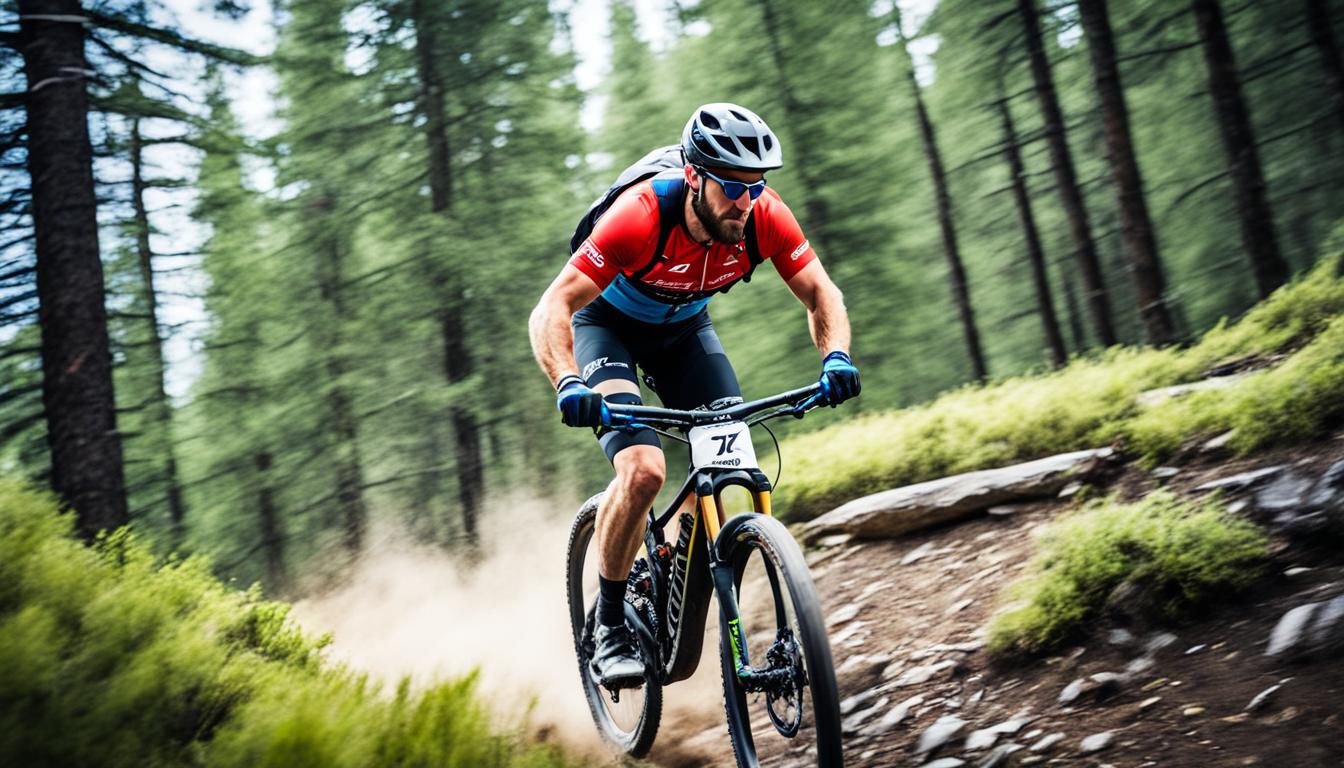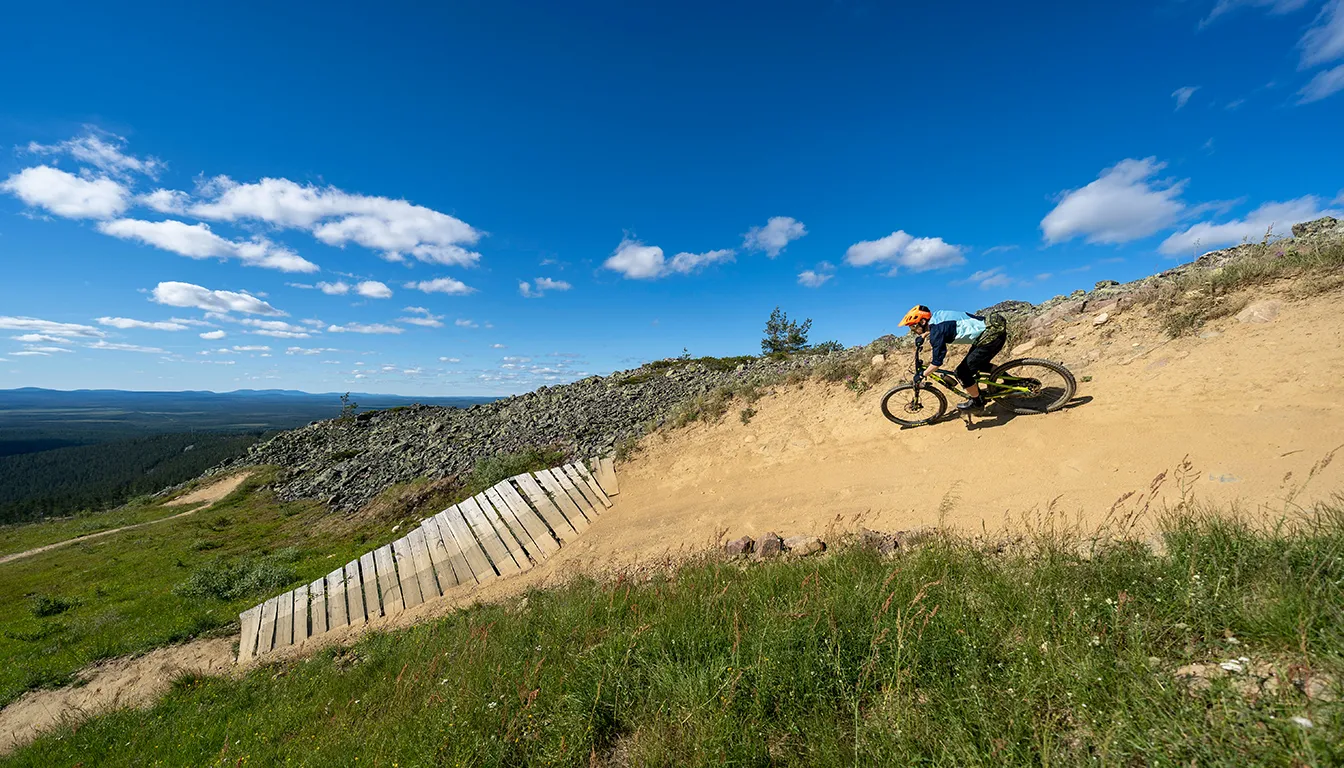Cross-country mountain biking combines endurance, strength, and skill. Riders face diverse terrains and obstacles. It’s vital to have a training plan tailored to the sport’s demands. This plan should improve your aerobic endurance, power, and bike handling. These skills are essential for races that last around 90 minutes.
Top athletes like Nino Schurter and Pauline Ferrand-Prévot show how important diverse training is. Their regimen includes long rides and intervals. They prepare thoroughly for race challenges. Also, following cross-country biking tips boosts stamina for tough races.
Understanding the Demands of XC Mountain Biking
XC mountain biking is not just about pedalling fast. It blends aerobic endurance, power, and technical skills. These are essential for overcoming diverse terrains. Merging these skills is key to doing well in competitions.
The Importance of Aerobic Endurance
Aerobic capacity plays a vital role in XC racing. Competitors must keep up their effort in races lasting from 1 hour 30 minutes to 2 hours. Those who shine in this sport manage tough climbs with ease. They maintain high power at a lower effort, thanks to their strong endurance.
Power and Strength Requirements
XC races throw steep climbs and tough landscapes at riders. This requires bursts of power and strength. Strength training becomes as important as aerobic workouts to prepare for these races. Achieving lower body weight can also help improve performance.
Technical Skills and Bike Handling
Being good at handling the bike is crucial. It makes cornering, descending, and maintaining control at high speeds easier. Riders should practice on challenging trails to get better. Training on B lines, as suggested here, is a good start.
Key Training Components for XC Success
To be great at cross-country mountain biking, you need a well-rounded training plan. It’s vital to work on your aerobic endurance, power, and skill on the bike. These are the core parts of training for XC races.
Long Steady Rides for Aerobic Development
Aerobic development is the foundation of XC training. By going on long, easy rides, you build the endurance needed for races. These sessions make you more efficient at using energy.
This means you can keep going in races that last up to two hours. It’s especially helpful for the tough parts of races with lots of uphill and downhill.
High-Intensity Interval Training for Power
Using HIIT in your training is key for explosive strength. It increases your power and helps you push harder for longer. This type of training involves intense efforts followed by short breaks.
It mirrors the real challenges of a race. This way, you’re ready for the quick shifts in pace and power that XC racing demands.
Technical Skills Practice
Improving your bike skills is crucial. Spending time on mastering difficult parts of a course pays off. It’s all about learning to handle sharp turns and steep drops better.
This not only makes you faster but saves energy too. Getting better at these skills means a big boost for your race results.
How to Train for XC Mountain Biking
To train well for cross-country mountain biking, you need a mix of strategies. These strategies help improve your racing skills. They include making your own race circuit and using plyometrics to get better at mountain biking.
Creating a Race Simulation Circuit
A good race circuit mimics a real race’s features. Include steep climbs, tricky descents, and different terrains. Plus, practising at race speed on this circuit helps you get used to competition conditions.
This boosts your confidence and skills. Trying to beat specific lap times can show where you need to get better. It helps you prepare more effectively.
Incorporating Plyometrics for Explosive Power
For mountain biking, plyometrics are key to gaining explosive speed. Such exercises work on your fast-twitch muscles. These are vital for powerful pedalling during climbs or quick sprints.
Adding plyometric exercises to your weekly routine boosts your racing performance. It builds the agility and strength needed for the race’s tough parts.
Developing an Effective Training Plan
Making a good training plan for XC mountain biking means having a set weekly plan. This plan should cover endurance, strength, and technique. A clear routine boosts performance and gets athletes ready for competitive races.
Weekly Training Schedule
Your weekly training should have different parts:
- Two days of hard training to increase power with interval workouts, improve starts, and get better at cornering.
- Several rides at a gentle pace to build stamina over time.
- Rest days to let the body heal and grow stronger, avoiding too much training.
Mixing tough workouts with easier rides improves fitness. Using different types of exercises keeps you motivated. It also works on key areas like VO2Max.
Periodisation and Recovery Strategies
MTB periodisation is key for peaking at the right time for competitions. Athletes should focus more on race-specific exercises as events get closer. This makes sure the training meets the needs of XC racing.
Recovery methods are just as important. Light rides help with muscle strength and getting used to the riding position. Active recovery helps athletes stay in shape without getting too tired.
Improvement often comes from time spent not riding. Rest days are when the body adjusts to the hard work. Eating well and staying hydrated help with both training and recovery, leading to better performance.
Nutrition and Hydration for Optimal Performance
Nutrition is key for XC athletes’ performance. A well-planned diet helps with training and recovery. This lets riders do well in races. Knowing how to tailor nutrition for yourself greatly impacts your trail success.
Importance of Carbohydrate Intake
Carbs are essential for energy in XC athletes. They are crucial before races to keep energy up. Aim for 8-12g of carbs per kilogram of body weight daily to boost performance. Include whole-food carbs in meals for better fuel. Stay away from refined carbs to avoid stomach problems during races. Good carb intake improves performance and lowers tiredness.
Hydration Strategies During Training and Races
Being well-hydrated is crucial for doing well in XC biking. Drink about one litre of fluid per hour to replace sweat lost. For rides longer than two hours, energy drinks with electrolytes are helpful. Proper hydration prevents cramps and tiredness, even in tough weather. In a six-lap race, changing water bottles at laps three and five is smart. Electrolyte drinks help keep up energy and deal with heat well.
Conclusion
To train for XC mountain biking successfully, you need a rounded approach. It’s essential to work on your fitness through endurance and strength exercises. You should also polish your technical riding skills. Good nutrition and staying hydrated are key for performing well and avoiding cramps during races.
Training 15-20 hours a week will help build up your resistance to fatigue. This means you can better manage the changing speeds of XC-MTB races. Also, the way your bike is set up and how you use your gears greatly impacts your performance and comfort on the trails.
If you’re serious about XC racing preparation, consider how skill building, recovery, and stamina work together. Aim for regular training sessions, follow specific nutrition plans, and pay attention to both your physical and technical skills. Careful planning and meeting the varied requirements of XC racing will help you succeed in competitions.
FAQ
What is the primary focus of XC mountain biking training?
The primary focus of XC mountain biking training is building a comprehensive plan. This plan covers aerobic endurance, power, and technical skills. It prepares riders for the sport’s physical and technical demands.
How important is aerobic endurance in XC racing?
Aerobic endurance is crucial in XC racing. It helps riders keep up their effort, particularly on hilly courses. It also cuts down fatigue in longer races.
What type of strength is needed for XC mountain biking?
To do well in XC mountain biking, riders must develop power through strength training. This training boosts their ability to surge on steep climbs and technical descents, which is key.
Why are technical skills important for XC racers?
Technical skills like bike handling and descending are vital for tough terrains. Mastering these skills greatly impacts race outcomes.
What kind of rides are beneficial for building aerobic capacity?
Long rides at a gentle pace boost aerobic capacity. These rides build a strong fitness base, enabling riders to last longer with less tiredness.
How does High-Intensity Interval Training (HIIT) help XC athletes?
HIIT increases power and anaerobic threshold for XC athletes. This is important for intense parts of the races.
What strategies can improve technical skills for XC racing?
Regular practice on different terrains helps better technical skills. Focusing on these skills often is crucial.
How can creating a race simulation circuit enhance training?
Crafting a local circuit that mimics real races betters practice quality. It enhances familiarity and confidence in actual competitions.
What role do plyometric exercises play in XC training?
Plyometric exercises like jumps boost fast-twitch muscle fibres. These muscles are vital for the explosive efforts needed in XC races.
What does a typical weekly training schedule for XC mountain biking look like?
A weekly training plan includes endurance, strength, skills practice, and rest. It features two intense sessions and steady aerobic exercises.
Why is periodisation important in XC training?
Periodisation ups training intensity before competitions. It also ensures rest, avoiding overtraining and injuries.
How should XC athletes manage their carbohydrate intake?
XC athletes need plenty of carbohydrates for training and racing energy, due to the sport’s intensity.
What are effective hydration strategies for XC mountain bikers?
Drinking about one litre per hour during activity is key. For longer than two hours, energy drinks help too.








